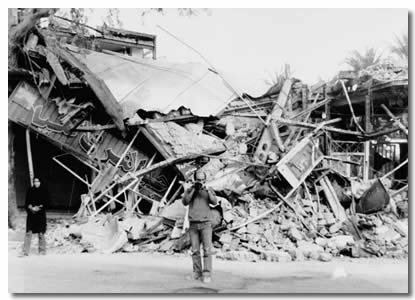The number of people killed in natural disasters reached 2003 people in 76,806, three times the number of people killed in 2002.
Nir Kosti

A building damaged by the earthquake in Iran.
Direct link to this page: https://www.hayadan.org.il/disaster2003.html
The number of people killed in natural disasters in 2003 reached 76,806 people, three times the number of people killed in 2002. A report published by the International Red Cross determines what the reasons for the apparent increase in the number actually were, and how the number of victims can be reduced.
According to the report published this week, the extreme increase in the number of deaths from 2002 to 2003 was due mainly to two natural disasters that claimed a total of 66 thousand victims. This is about the earthquake that occurred in Iran and claimed about 31 thousand victims and the heat wave that hit Europe, in which about 36 thousand people were killed.
But if you thought that was the end of the matter - you were wrong. About 250 million people suffered from drought, heavy rains, earthquakes, etc., which caused not only the loss of the aforementioned 76,806 people, but also damages twice as heavy as in 2, worth close to 2002 million dollars.
And we were lucky. The number of victims could have reached much higher numbers, but due to early preparation, quite a few human lives were saved. If so, first aid courses, emergency situations and the construction of buildings with more stable foundations, may reduce the number of deaths in the future and should be carried out immediately.
Conclusions and drawing lessons from the earthquake that occurred in southern Iran in the city of Bam
The report states that Iran's situation, which is characterized by a lack of awareness of natural disasters and a lack of enforcement related to the construction of buildings, was a major factor in the death of a significant number of the city's residents in the earthquake, which, as I recall, had a magnitude of 6.8 on the Richter scale.
The earthquake also left around 30,000 people homeless and revealed "a serious problem in Iran's preparation for natural disasters, one of the factors of which is the incessant competition between the Iranian army and the Red Crescent".
At the same time, the report finds it appropriate to praise the rescue teams in Iran who saved hundreds of people, but with the help of a higher budget, the international rescue teams could also have saved a much higher number of people.
If so, crowded cities in Iran, for example the capital city, Tehran, which has about 12 million people, are described according to the report as "ticking bombs". In Tehran, since 1830, an earthquake of enormous proportions has not occurred. Therefore, the report warns Iran to beware of earthquakes in major cities, and the current situation must be changed as soon as possible.
The report also states that Khartoum, the capital of Sudan, is an excellent example of a place where most residents are prepared for the heavy rains that hit the country every year. Every day tours are conducted by local volunteers in order to check if the river water might flood the houses. When this happens, the volunteers warn residents with the help of drums and the mosques' amplification systems. As a result of the preparations in advance, 15,000 residents of the city are facing the floods and flash floods that hit the city, without the need for outside help.
Environmentalist - Earth
https://www.hayadan.org.il/BuildaGate4/general2/data_card.php?Cat=~~~991494157~~~40&SiteName=hayadan
